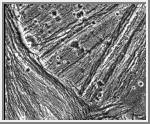 Galileo Images of Ganymede
Galileo Images of Ganymede Galileo Images of Ganymede
Galileo Images of Ganymede
The Galileo spacecraft returned these close-ups of Ganymede revealing that its surface has been extensively bombed by comets and asteroids and dramatically wrinkled and torn by the same forces that make mountains and move continents on Earth.
In addition, the physics instruments on Galileo made the major discovery that Ganymede possesses its own magnetosphere, a bubble-shaped region of charged particles that surrounds many of the planets but has never been found to exist around a moon. The finding indicates that Ganymede very likely creates its own magnetic field. Possible sources of a magnetic field include a molten iron core or even a thin layer of conducting salty water underneath its icy crust. The newly found magnetosphere is contained within Jupiter's magnetosphere.
The plasma wave spectrometer showed that the densities of charged particles around Ganymede increased by a factor of more than 100 near Galileo's closest approach. This indicates that Ganymede is surrounded by a thin ionosphere, which in turn suggests the existence of a tenuous atmosphere.

The following images were released to the public on July 10, 1996.
 Uruk Sulcus Region
(JPEG, 150K)
Uruk Sulcus Region
(JPEG, 150K)
Ridges, grooves, craters and relatively smooth areas in the Uruk
Sulcus region of Jupiter's moon Ganymede are shown in this
high-resolution image captured by NASA's Galileo spacecraft
during its first flyby of Ganymede on June 27, 1996. This image
was taken when Galileo was 7,448 kilometers (4.628 miles) away
from Ganymede; north is to the top of the picture, and sunlight
illuminates the surface from the lower left nearly overhead (77
degrees above the horizon). The area shown, at latitude 10
degrees north, longitude 168 degrees west, is about 55 by 35
kilometers (34 by 25 miles); the smallest features that can be
discerned are 74 meters (243 feet). The line-like features are
sunlit ridges, often arranged in parallel sets. The patterns of
ridges and grooves indicate that extension (pulling apart) and
shear (horizontal sliding) have both shaped the icy landscape.
 Voyager/Galileo Comparison
(JPEG, 145K)
Voyager/Galileo Comparison
(JPEG, 145K)
These images demonstrate the dramatic improvement in the
resolution of pictures that NASA's Galileo spacecraft is
returning compared to previous images of the Jupiter system. The
frame at left was taken by the Voyager 2 spacecraft when it flew
by in 1979, with a resolution of about 1.3 kilometers (0.8 mile)
per pixel. The frame at right showing the same area was captured
by Galileo during its first flyby of Ganymede on June 27, 1996;
it has a resolution of about 74 meters (243 feet) per pixel, more
than 17 times better than that of the Voyager image. In the
Voyager frame, line-like bright and dark bands can be seen but
their detailed structure and origin are not clear. In the
Galileo image, each band is now seen to be composed of many
smaller ridges. The structure and shape of the ridges permit
scientists to determine their origin and their relation to other
terrains, helping to unravel the complex history of the
planet-sized moon. In each of these frames, north is to the top,
and the sun illuminates the surface from the lower left nearly
overhead (about 77 degrees above the horizon). The area shown,
at latitude 10 degrees north, 167 degrees west, is about 35 by 55
kilometers (25 by 34 miles). The image was taken June 27 when
Galileo was 7,448 kilometers (4.628 miles) away from Ganymede.
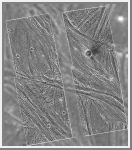 Ridges and Troughs
(JPEG, 397K)
Ridges and Troughs
(JPEG, 397K)
A mosaic of four Galileo high-resolution images of the Uruk
Sulcus region of Jupiter's moon Ganymede is shown within the
context of an image of the region taken by Voyager 2 in 1979.
The image shows details of parallel ridges and troughs that are
the principal features in the brighter regions of Ganymede. The
Galileo frames unveil the fine-scale topography of Ganymede's
ice-rich surface, permitting scientists to develop a detailed
understanding of the processes that have shaped Ganymede.
Resolution of the Galileo images is 74 meters (243 feet) per
pixel, while resolution of the Voyager image is 1.3 kilometers
(0.8 mile) per pixel. In this view, north is to the top, and the
sun illuminates the surface from the lower left nearly overhead.
The area shown, at latitude 10 degrees north, longitude 168
degrees west, is about 120 by 110 kilometers (75 by 68 miles) in
extent. The image was taken June 27 at a range of 7,448
kilometers (4,628 miles).
 Mixture of Terrains in Uruk Sulcus
(JPEG, 132K)
Mixture of Terrains in Uruk Sulcus
(JPEG, 132K)
A mixture of terrains studded with a large impact crater is shown
in this view of the Uruk Sulcus region of Jupiter's moon Ganymede
taken by NASA's Galileo spacecraft during its first flyby of the
planet-sized moon on June 27, 1996. The image shows fine details
of bright areas that make up about half of the surface of
Ganymede. Pock-marked, ancient, heavily cratered terrain is seen
at the top; it is cut by younger, line-like structures in the
lower left of the image. The bright, circular feature in the
lower middle is an impact crater with some dark ejecta
superimposed on the linear ridges. These types of relationships
revealed by Galileo allow scientists to work out the complex
geologic history of Ganymede. In this view, north is to the top
and the sun illuminates the surface from the lower left nearly
overhead. The area shown, at latitude 10 degrees north,
longitude 168 degrees west, is about 55 by 35 kilometers (34 by
25 miles), and the smallest features that can be seen are 74
meters in size. The image was taken on June 27 at a range of
7,448 kilometers (4.628 miles).
 Galileo Regio
(JPEG, 81K)
Galileo Regio
(JPEG, 81K)
This view of a part of the Galileo Regio region on Jupiter's moon
Ganymede shows fine details of the dark terrain that makes up
about half of the surface of the planet-sized moon. One of many
ancient impact craters in the region is visible at the middle
left. The crater is cut by numerous fractures, showing that the
ancient crust was highly deformed early in Ganymede's history.
Dark areas may have originated from dark material thrown off by
dark meteorites hitting the surface in thousands of impact
events. In this view, north is to the top and the sun
illuminates the surface from the lower left about 58 degrees
above the horizon. The area shown, at latitude 19 degrees north,
longitude 149 degrees west, is about 19 by 26 kilometers (12 by
16 miles); resolution is about 80 meters (262 feet) per pixel.
The image was taken June 27 at a range of 7.652 kilometers (4,755
miles).
 Ancient Terrain in Galileo Regio
(JPEG, 166K)
Ancient Terrain in Galileo Regio
(JPEG, 166K)
Ancient impact craters shown in this image of Jupiter's moon
Ganymede taken by NASA's Galileo spacecraft testify to the great
age of the terrain, dating back several billion years. At the
margin at the left, half of a 19-kilometer-diameter (12-mile)
crater is visible. The dark and bright lines running from lower
right to upper left and from top to bottom are deep furrows in
the ancient crust of dirty water ice. The origin of the dark
material is unknown, but it may be accumulated dark fragments
from many meteorites that hit Ganymede. In this view, north is
to the top, and the sun illuminates the surface from the lower
left about 58 degrees above the horizon. The area shown is part
of Ganymede's Galileo Regio region at latitude 18 degrees north,
longitude 147 degrees west; it is about 46 by 64 kilometers (29
by 38 miles) in extent. Resolution is about 80 meters (262 feet)
per pixel. The image was taken June 27 at a range of 7.563
kilometers (4,700 miles).
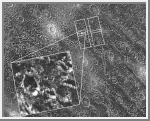 Detail of the furrowed region of Galileo Regio
(JPEG, 154K)
Detail of the furrowed region of Galileo Regio
(JPEG, 154K)
View of the Galileo Regio region on Ganymede showing fine details
of the Galileo image fit into the larger scale, but much lower resolution
view of the region taken 17 years earlier by Voyager. The broad curved
furrow patterns are characteristic of the darker regions of this moon.
North is to the top of the picture and the sun illuminates the surface
from almost overhead in the Galileo picture.
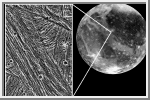 Detail of Uruk Sulcus
(JPEG, 175K)
Detail of Uruk Sulcus
(JPEG, 175K)
View of a portion of the Uruk Sulcus region on Ganymede showing how
the fine details of the grooved terrain that are the principal features
in the brighter regions of this satellite relate to the global view
of the moon. North is to the top of the inset picture and the sun
illumination is almost overhead. The global view is a Voyager picture
taken in 1979.
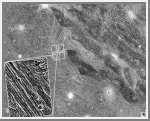 Detail and context of Galileo Uruk Sulcus pictures
(JPEG, 236K)
Detail and context of Galileo Uruk Sulcus pictures
(JPEG, 236K)
View of the region of Ganymede'=EDs Uruk Sulcus placed on a lower
resolution Voyager view taken 17 years earlier. North is to the
top of the picture and the sun illuminates the surface from almost
overhead in the Galileo view. The finest details that can discerned
in the Galileo picture are about 80 meters across. The four boxes
outlined in white show the extent of Galileo's initial look at this area.
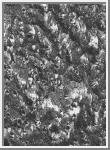 High Resolution detail of Galileo Regio
(JPEG, 38K)
High Resolution detail of Galileo Regio
(JPEG, 38K)
This picture shows a segment of a Galileo image of the Galileo Regio
region on Jupiter's moon Ganymede. Features in the curved furrows that
characterize this region can be seen even with very high sun
illumination. North is to the top of the picture. The finest details
that can discerned are about 80 meters across.

